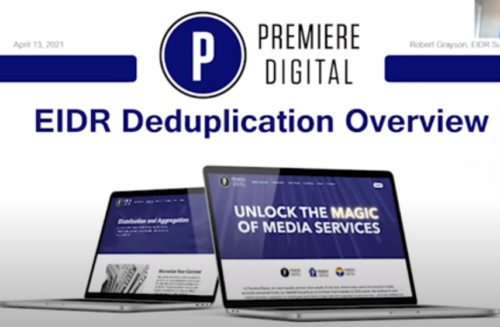Premiere Digital Services (PDS) supports EIDR in a key technical role: the deduplication process, according to Robert Grayson, EIDR support manager at PDS.
“We work with EIDR to help meet its support goals,” as well as “deduplication and other technical needs that it happens to run across,” he said during the Dedupe, Automation & Apps breakout session “PDS Supporting EIDRs – The Deduplication Process” that was part of the April 13 EIDR Annual Participant Meeting.
During the session, he highlighted his company’s work with EIDR: from the services it provides for EIDR to how it utilizes the universal identifier. He provided an idea of what a typical day is like from the perspective of an EIDR member seeking to register an asset into the EIDR Registry. Grayson explained the process from the perspective of a support agent, giving a look behind the scenes of the manual deduplication review process.
 Member registration is “where it all starts,” he noted, explaining: “There are multiple ways a member can register a record,” from manual registration to the Web User Interface (UI), using the application programming interface (API) and “even bulk registration through other means as well.”
Member registration is “where it all starts,” he noted, explaining: “There are multiple ways a member can register a record,” from manual registration to the Web User Interface (UI), using the application programming interface (API) and “even bulk registration through other means as well.”
He provided a registration demonstration using EIDR Sandbox and emphasized the importance of content data quality and meeting the minimum basic metadata.
While highlighting Web UI registrations, he pointed out there are records for movies and TV shows including individual episodes and seasons. There are records for different versions of the same movie and TV program that each get a different EIDR ID, he noted, providing as examples the original four-part version of the TV show Doctor Thorne and a version with all of the parts combined into a single work, similar to what is done with the TV miniseries Roots. You can also have separate records for different movie trailers of the same film.
“Every reference type or object type has its own minimum data requirements for registration,” Grayson also explained. “This is actually something that has changed over time… and it varies drastically based on what you’re attempting to do. For example, if you went back and used a compilation record, they’re great for DVDs, Blu-rays or special packages of other works.”
What makes the process easier is that the Web UI “will actually guide you on what you need to do” when entering the data into a record registration, he pointed out.
Moving on to deduplication, he intentionally triggered a dedupe prompt and went over the responses and options for members.
If you enter a duplicate, a notice will appear on the screen saying: “The following problems were detected: This record appears to already exist…. Use the existing content ID if it does match the attempted registration. If it does NOT match then use the ‘request manual deduplication’ button or modify the registration data to differentiate it more and try again.”
A member using the system can “request manual deduplication if you’re unsure” if a record is a duplicate or not, he said, adding: “If it was already registered, we will match it to the existing record regardless. It will actually point you to the record that we pointed it to.”
It is “not a perfect process,” he conceded, but added: “With the EIDR team and PDS and everybody else involved, we are working to always improve the logic.”

